On a daily basis, there is a litany of articles and advertisements encouraging you to invest your savings with the promise of future wealth and retirement security.
But which is right?
First, let’s clear up a misconception.
You are NOT an investor. You are a SAVER.
You go to work every day, work hard for the paycheck you receive, of which you “save a few shillings” to put away for a “rainy day.”
If you do it right, you get to retire with enough savings to continue living in the manner with which you have become accustomed.
Do it wrong, such as “undersaving” with the hopes that higher rates of return will make up the difference, and problems arise. This is the case with all of the municipal pensions funds in the U.S. currently facing a $4-5 Trillion dollar shortfall.
Which Method You Choose Matters
As a “saver,” trying to reach our financial objectives, we have three primary responsibilities:
- Have an appropriate savings rate for our goals,
- Ensure those savings adjust for inflation over time, and;
- Don’t lose it.
There have been plenty of times in history where you literally could stick your money in a “savings” account and earn enough, “risk-free,” to “save” your way to retirement. The chart below shows the savings rate on short-term deposits adjusted for inflation.
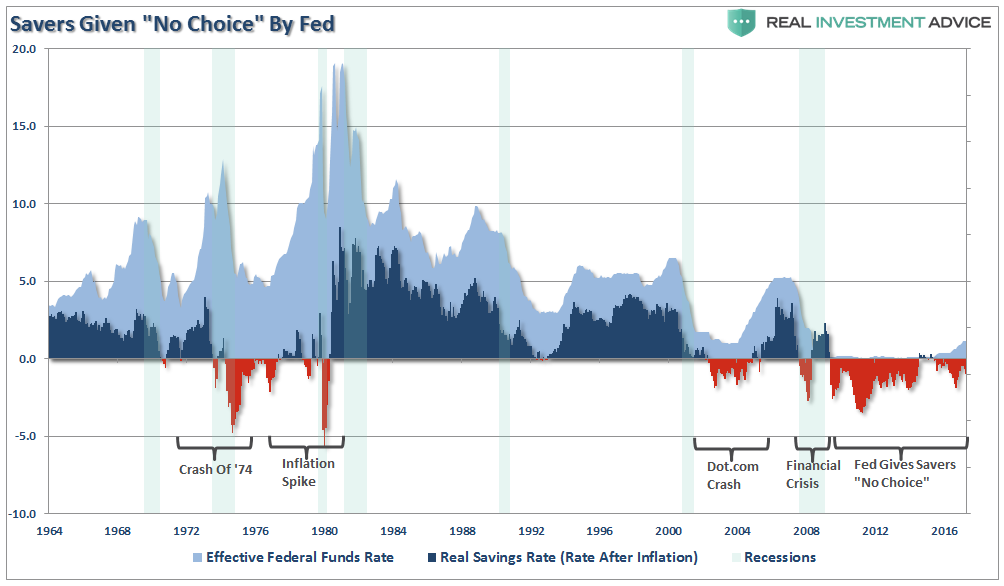
You will notice that when the Federal Reserve “goes on the attack” to battle recessionary drags brought on by their very own “rate hike” campaigns, savers paid the price. In the major bear markets of 1974, 2000 and 2008, the rate has gone negative giving investors few choices but to “seek yield” by taking on more aggressive investment risk.
Currently, I won’t argue that you do need to “put your savings” to work in the market. The Federal Reserve’s campaign since the “Financial Crisis” has been to force “savers” out of cash and into the financial markets to bail out banks, Wall Street and create a “wealth effect” that would “trickle down” through the economy.
Well, as they say, “two out of three ain’t bad.”
Unfortunately, for the average American, the current “negative savings rate” will no longer suffice in ensuring your savings adjust for purchasing power parity in the future.
So, as a saver, which method of “saving” for your retirement should you choose in order to accomplish the three basic goals noted above?
Here are your 3-options:
(1) Buy a portfolio of low-cost indexed funds and dollar cost average annually.
(Buy, hold and ride it out)
(2) Buy a portfolio of gold
(Come on…you’ve heard the commercials)
(3) Buy a portfolio of indexed funds and manage the portfolio against drawdowns.
(Don’t be silly, everyone knows you will underperform doing that.)
First, let’s make a few simple assumptions for our model.
Bob is 35-years old, earns $75,000 a year, saves 10% of his gross salary each year and wants to have the same income in retirement that he currently has today. In our forecast, we will assume the market returns 7% each year (same as promised by financial advisors everywhere) and we will use 2.1% for inflation (long-term median) for planning purposes.
In 30 years, Bob’s equivalent income requirement will roughly be $137,000 annually.
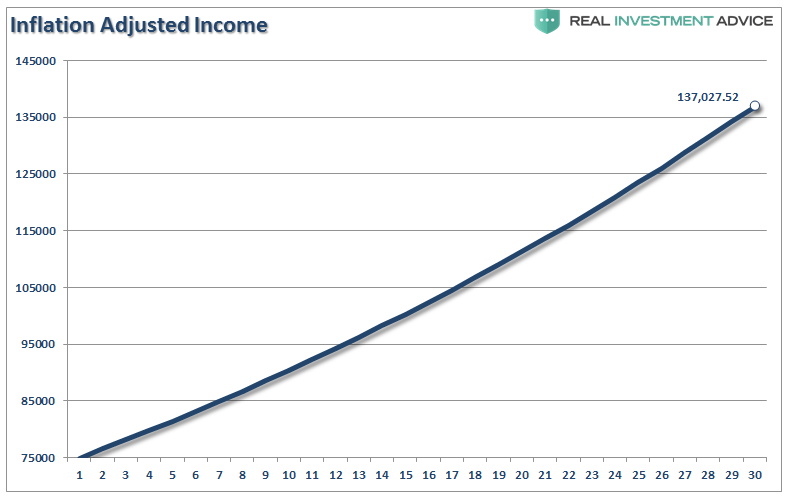
This is where problem number one arises for the vast majority of Americans. Given the economic drag of the 3-D’s (Debt, Demographics and Deflation,) which will span the next 30-years, long-term interest rates will remain low. Therefore, if we assume that a portfolio can deliver an income of 3% annually, the assets required by Bob to fulfill his retirement needs of $137,000 annually will be roughly $4.6 Million.
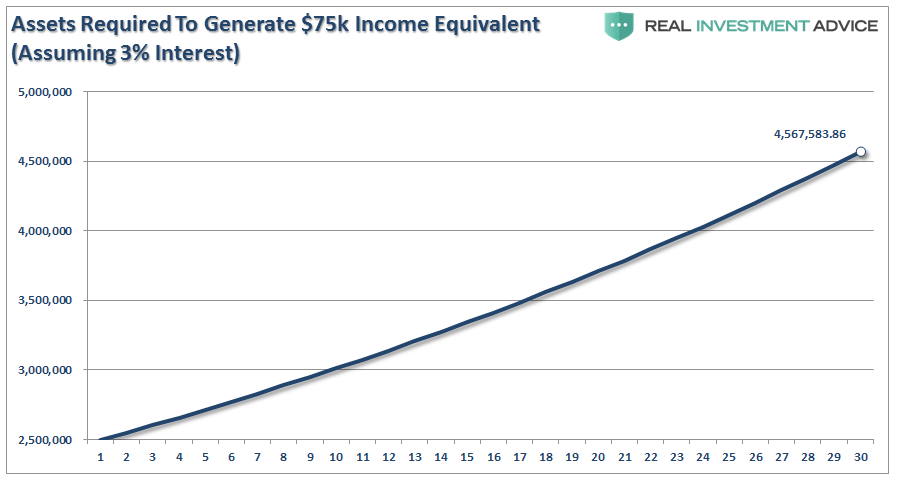
(Yes, I have excluded social security, pensions, etc. – this is for illustrative purposes only.)
We are also going to assume that Bob has been a diligent saver and has accumulated a nest egg of $100,000 to jump-start his savings adventure AND he will start investing in 1988 following the 1987 crash. (I am giving Bob every benefit I can here.)
The Assumptions
- Portfolio 1 – “Buy and Hold:” – the “real” total return, dividend reinvested, S&P 500 index.
- Portfolio 2 – “Buy Gold” – the gold index price (since gold is supposed to adjust for inflation)
- Portfolio 3, – “Risk Managed” – the “real” total return S&P 500 index, but will switch to cash when the S&P 500 violates its 12-month moving average.
- Each portfolio will be “dollar cost averaged” at a rate of $650/month or $7500/annually.
(I have not included fees, taxes, and expenses, which also reduces long-term returns, which I have covered previously here.)
Method 1: Buy and Hold
The first method assumes Bob invests his $100,000 into the market in 1988 and diligently saves $650 per month. It certainly appears that Bob has done well for himself, as shown below, by retiring with $1.6 million dollars in the bank.
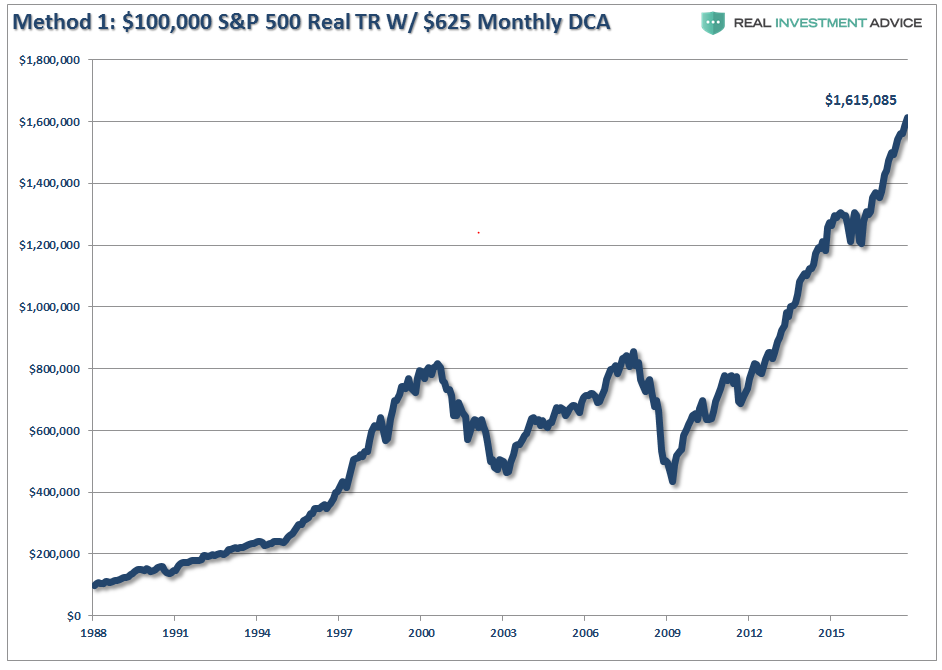
Method 2: Gold
“Call today and convert your IRA into the safety and security of GOLD.”
Gold is a commodity which pays no dividend but is supposed to adjust for the inflationary pressures in the economy. “Gold is a store of value.”
If we assume Bob invested his $100,000 into gold in 1988, and diligently bought $650 worth of gold each month, his value at retirement is just $871,000. Not bad, there are few that would scoff at a bank account of over $850,000, but gold underperformed the financial market over the same period.
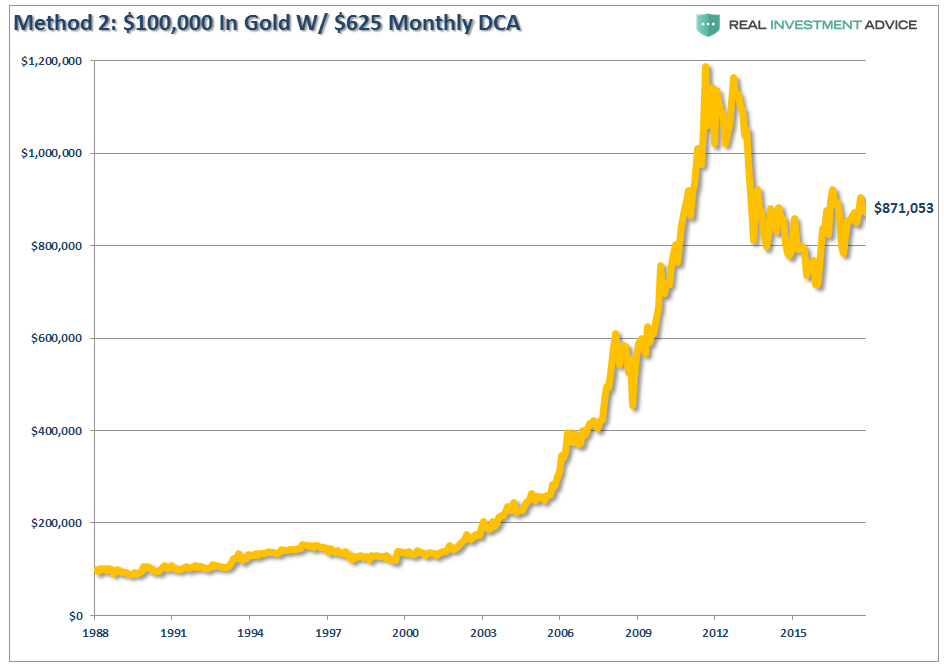
(Note: I am NOT saying one should never own gold – period. I just disagree with those who suggest it is ALL you should own.)
Method 3: Risk Managed
The final method, as shown below, is a “risk managed” approach to investing capital. In this case, Bob invests his $100,000 into the S&P 500 (inflation-adjusted, total return) index in 1988 and, as above, diligently saves $650 per month.
The difference is that when the S&P 500 index crosses below the 12-month moving average, Bob moves everything into cash, and keeps saving monthly, until the S&P 500 reverses back above the 12-month average.
Bob was often chastised by his friends for “getting out of the market” too soon, or for “staying out too long.” Bob never paid attention, but stayed true to his discipline and investment strategy and grew his savings to over $5 million dollars.
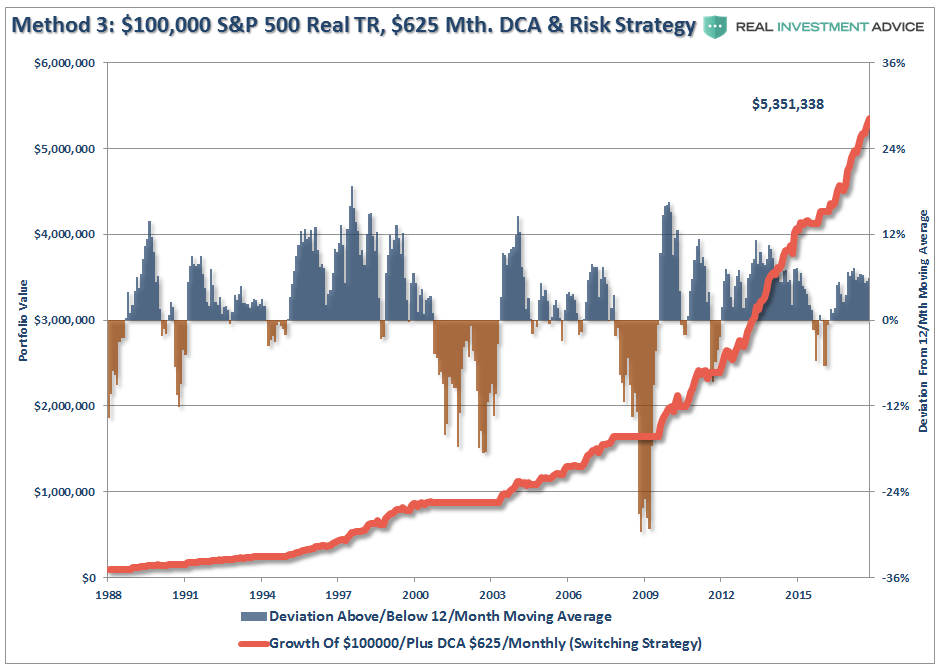
(Note: This is a simplified example. In our actual money management practice we scale between stocks and fixed income to protect income streams for retirees but reduced risk to capital.)
Once you set aside the daily media chatter, sales pitches, poor investment advice and investing methods that have a complete lack of evidence to support them, you find out one simple truth:
“Managing the risk of drawdowns is what separates having enough money to live out your retirement dreams, or not.”
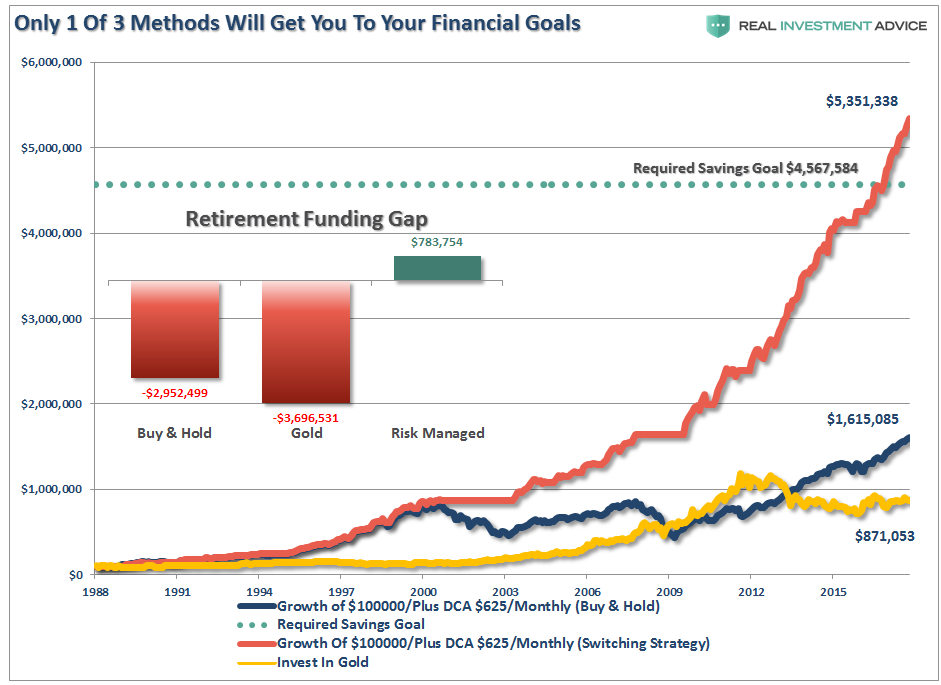
With this in mind, the reality of saving for your retirement should be clear as 2 of the 3 methods discussed above leave you well short of your financial goals.
- “Buy and Hold” leaves you nearly $3 million short
- “Gold” leaves you more than $3.6 million behind; but
- “Risk Managed” has the best chance at succeeding.
The “Saver’s” Guide
Unfortunately, the vast majority of advice proffered by financial media, advisors, analysts and even financial planners is simply wrong. If your financial planning includes any of the following assumptions, you run a very high risk of falling short of your goals.
- Compounded rates of return,
- Projected return rates without consideration of starting valuations,
- Ignores the effects of capital destruction (annual or monthly return variability), and;
- Duration risk
I gave Bob every benefit I could by:
- Giving him a large “nest egg” to start
- 30-years to his goal
- An annual salary 50% higher than the national mean,
- And starting and ending his investment cycle with a ripping “bull market.”
The majority of those embarking on their savings journey have far fewer benefits at their disposal which makes the challenge markedly more difficult. In fact, as discussed in “The Bottom 90% and The Failure Of Prosperity”, the majority of Americans are financially devastated. Wages have remained stagnant, savings rates are low, and most are heavily leveraged. Furthermore, with valuations exceedingly elevated, forward returns will be substantially lower and more volatile than what was witnessed previously.
Controlling risk, reducing emotional investment mistakes and limiting the destruction of investment capital will likely be the real formula for investment success in the decade ahead.
With this in mind, individuals need to carefully consider the factors that will affect their future outcomes.
- Expectations for future returns and withdrawal rates should be downwardly adjusted.
- The potential for front-loaded returns going forward is unlikely.
- The impact of taxation must be considered in the planned withdrawal rate.
- Future inflation expectations must be carefully considered.
- Drawdowns from portfolios during declining market environments accelerate the principal bleed. Plans should be made during rising market years to harbor capital for reduced portfolio withdrawals during adverse market conditions.
- The yield chase over the last 8-years, and low interest rate environment, has created an extremely risky environment for retirement income planning. Caution is advised.
- Expectations for compounded annual rates of returns should be dismissed in lieu of plans for variable rates of future returns.
Chasing an arbitrary index that is 100% invested in the equity market requires you to take on far more risk that you likely want. Two massive bear markets over the last decade have left many individuals further away from retirement than they ever imagined. Furthermore, all investors lost something far more valuable than money – the TIME that was needed to reach their retirement goals.
As an investment manager, I am neither bullish or bearish. I simply view the world through the lens of statistics and probabilities. My job is to manage the inherent risk to investment capital. If I protect the investment capital in the short term – the long-term capital appreciation will take of itself.
Investing for retirement, no matter what age you are, should be done conservatively and cautiously with the goal of outpacing inflation over time. This doesn’t mean that you should never invest in the stock market, it just means that your portfolio should be constructed to deliver a rate of return sufficient to meet your long-term goals with as little risk as possible.
Yes, you can manage the risk in your portfolio.
You just have to turn off the media to do so.
There should be no one more concerned about YOUR money than you, and if you aren’t taking an active interest in your money – why should anyone else?
